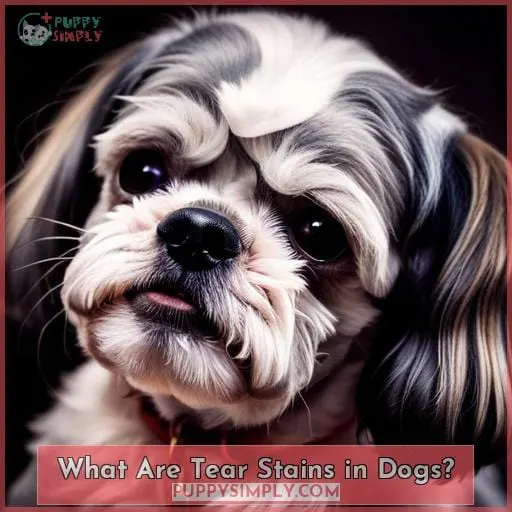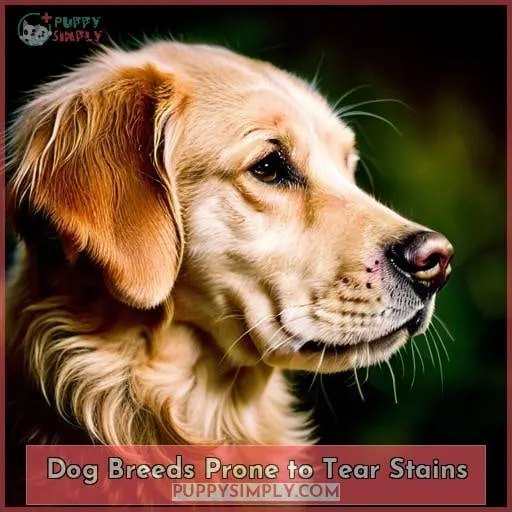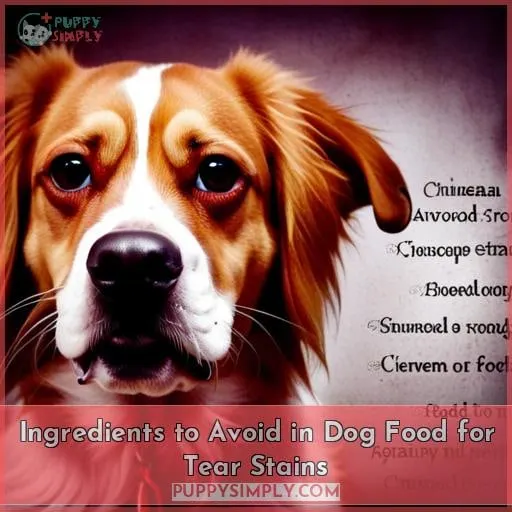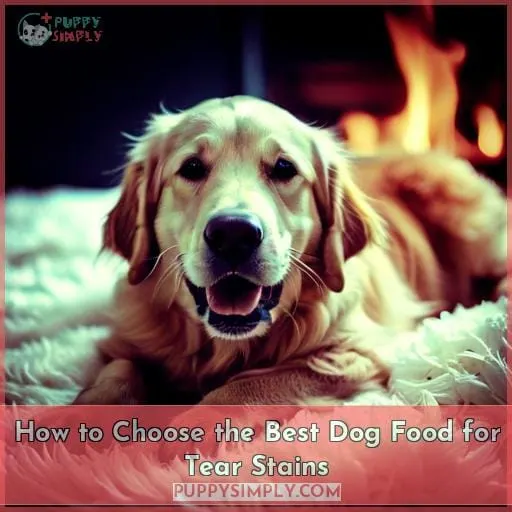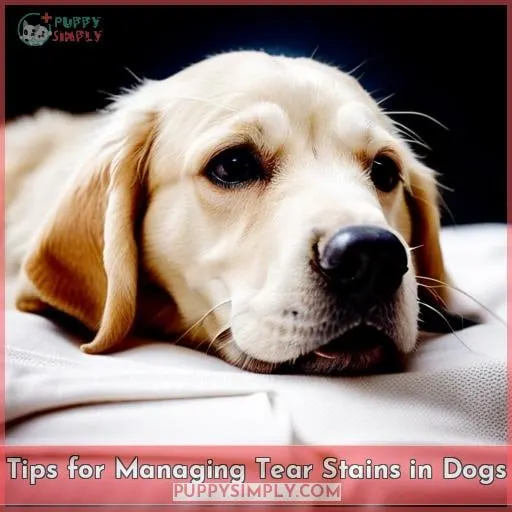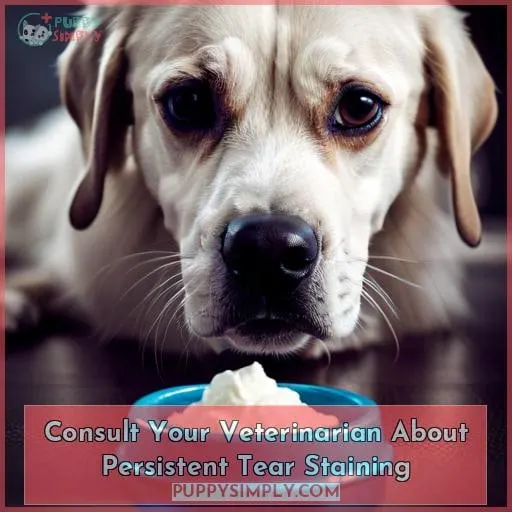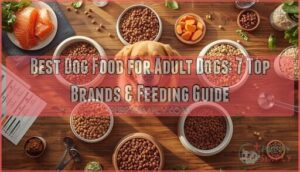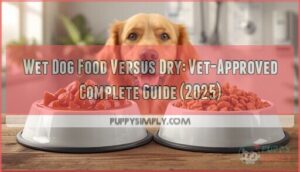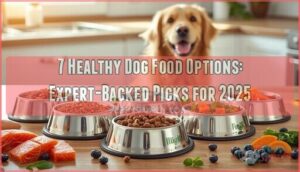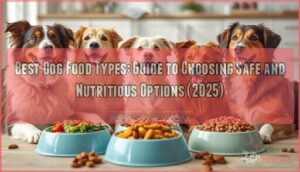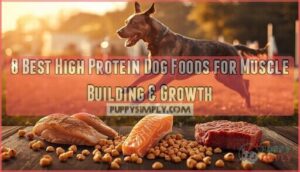This site is supported by our readers. We may earn a commission, at no cost to you, if you purchase through links.
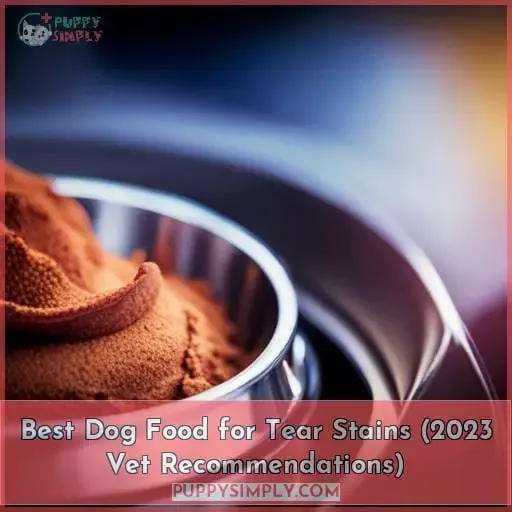
As her doting parent, you’re determined to get to the root of those vexing tear stains so your pup’s true beauty can shine through.
The solution may lay in finding the best dog food for tear stains. See, what Sadie eats can directly impact the health of her eyes and skin, and the wrong diet could exacerbate watery eyes and staining.
Together, let’s find her the perfect formula, rich in omega fatty acids, vitamin E, and A to nourish her from the inside out. With the right food choice, those annoying streaks don’t stand a chance against your can-do attitude and Sadie’s natural radiance.
She’s relying on you for the TLC she needs, so grab a treat, cuddle up close and let’s get started.
Table Of Contents
- Key Takeaways
- What Are Tear Stains in Dogs?
- What Causes Tear Staining in Dogs?
- Dog Breeds Prone to Tear Stains
- Ingredients to Avoid in Dog Food for Tear Stains
- How to Choose the Best Dog Food for Tear Stains
- 10 Best Dog Foods for Tear Stains
- 1. Zignature Duck Limited Ingredient Dog Food
- 2. Wellness Core Grain Free Small Breed Turkey Chicken Dog Food
- 3. Merrick Grain Free Sweet Potato Chicken Free Dog Food
- 4. Blue Buffalo Basics Grain Free Turkey Potato Dog Food
- 5. Rachael Ray Nutrish Lamb Meal and Brown Rice Dog Food
- 6. Royal Canin Maltese Adult Dog Food
- 7. Firstmate Grain Free Chicken Blueberry Dog Food
- 8. Lucy Pet Grain Free Duck Potato Dog Food
- 9. Halo Digestive Health Salmon Whitefish Dog Food
- 10. Angels Eyes Plus Chicken Flavored Tear Stain Supplement Dogs Cats
- Tips for Managing Tear Stains in Dogs
- Consult Your Veterinarian About Persistent Tear Staining
- Frequently Asked Questions (FAQs)
- How long does it take to see results after switching my dog’s food?
- Should I transition my dog gradually to the new food or switch completely at once?
- Are there any risks or side effects associated with changing my dog’s diet for tear stains?
- Will my dog’s tear stains completely disappear or just improve on the recommended diets?
- Should I give my dog supplements in addition to the tear stain food for better results?
- Conclusion
Key Takeaways
- Grain-free or limited-ingredient dog foods can help reduce tear stains, as grains and other ingredients can trigger allergic reactions.
- Diets rich in omega fatty acids and antioxidants may improve tear staining by reducing inflammation.
- Novel protein sources like venison or kangaroo can help identify food allergies that may be causing excessive tearing.
- When switching foods to improve tear stains, make gradual transitions over 5-7 days to allow your dog’s digestive system to adjust.
What Are Tear Stains in Dogs?
Tear stains in pups are those reddish-brown streaks below the eyes that can really mess up their cute faces. As your trusted veterinarian, I want to explain what causes these pesky stains so we can work together to keep your dog looking their best.
Tear staining happens when tears overflow the eyelids and run down the face. Certain breeds like Maltese are more prone due to their flat face shape. But many factors can lead to excessive tearing, including irritation from shampoos or environmental allergens, clogged tear ducts, eye infections, and reactions to ingredients or fillers in food.
Diet definitely plays a role – poor quality kibble with artificial colors, preservatives, or grains can upset your pup’s tummy and lead to more tears.
The good news is we can tackle this through grooming, medication if needed, and switching to a natural, limited ingredient diet made with digestible proteins and antioxidants. With some trial and error to find what works for your unique pooch, you’ll have those adorable tear-free eyes and face you love so much.
What Causes Tear Staining in Dogs?
You’d be surprised to learn that over 20% of dogs suffer from excessive tear production, which can lead to unsightly reddish-brown staining around the eyes.
- Blocked Tear Ducts
- Allergies
- Irritation
- Facial Structure
Certain breeds like Maltese, Poodles, and Cocker Spaniels are more prone to tear stains due to their face shape. For puppies, it’s common as tear ducts are still developing. Food allergies or sensitivities, especially to grains, can also lead to excess tearing.
Environmental irritants like dust and pollen may overstimulate tear production. In some cases, a puppy tooth emerging incorrectly can cause pain and extra tears.
While unsightly, tear stains themselves are harmless and can be managed with a combination of cleaning, diet changes, and care.
Dog Breeds Prone to Tear Stains
Maltese and other small breeds tend to be more prone to tear staining issues. Certain breeds like Maltese, Shih Tzus, Poodles, Bichon Frise, and Pekingeses are more susceptible to tear staining due to their genetics, facial structure, and coat color.
Their tear ducts can be too narrow or misaligned, leading to excessive tear production that causes reddish-brown stains under the eyes.
While all dogs can potentially develop tear stains, these toy breeds with white coats tend to show staining more noticeably. As your canine’s eye health advocate, I recommend being attentive to any excessive tearing and discussing natural remedies or dietary changes with your veterinarian.
Tear staining frustrates many owners, but future research on improving eye health and stain prevention for sensitive dogs gives me hope.
With patience and proactive care, those pesky stains don’t have to be a lifelong nuisance.
Ingredients to Avoid in Dog Food for Tear Stains
Corn and wheat are fillers you wanna avoid when picking a dog food for tear stains. They provide little nutritional value and can irritate your pup’s eyes and skin. You’ll also want to steer clear of fuel-based preservatives, excess synthetic additives, overly rich proteins, and reactive binders that can overwhelm your dog’s sensitive digestive system.
Instead, look for a limited ingredient diet with digestible meat proteins like fish, chicken or turkey and avoid common allergens like beef, dairy and eggs. The fewer extra fillers, the better. Focus on quality over quantity when reading the label.
A short, clean ingredient list free of junk is ideal for reducing tearing and stains.
How to Choose the Best Dog Food for Tear Stains
When selecting a dog food to help reduce tear staining, focus on limited ingredient formulas with antioxidant-rich fruits and vegetables that support eye health.
Look for recipes with easily digestible proteins like fish or novel meats to avoid triggering food sensitivities or allergies that can lead to excessive tearing. Kangaroo, duck, or venison may be less likely to cause issues than chicken or beef.
Try to find grain-free and gluten-free recipes without corn, wheat, soy, or fillers that can get stuck in tear ducts.
Make sure the food is fortified with vitamins A, C, E to support eye health. Omega fatty acids from fish oils promote tear production and lubrication.
Slowly transition to a new formula over 5-7 days if your pup is a picky eater. Gradually incorporate the new kibble into their usual dry dog food to avoid gastric upset from sudden changes.
Consult your veterinarian, as they can recommend appropriate foods and supplements based on your dog’s unique health needs and sensitivities.
10 Best Dog Foods for Tear Stains
Carefully chosen limited ingredient diets with highly digestible proteins, probiotics, and antioxidants can improve eye health. Working with your veterinarian to find a high quality food tailored to your dog’s individual needs and sensitivities is recommended.
Patience is key, as resolving any underlying causes of tear staining takes time.
Opting for a diet with fewer ingredients can help pinpoint any food intolerances. Digestible proteins like chicken, fish, or egg are gentle on the gut. Probiotics support healthy digestion while antioxidants reduce inflammation.
When selecting a dog food, check the label for whole protein sources as the first ingredients. Avoid fillers like corn, wheat, soy, and excess carbohydrates. Some dogs do better on grain-free recipes.
As each dog is unique, be willing to trial a few limited ingredient dog foods. It can take 8-12 weeks to see improvements as you identify triggers.
Work closely with your veterinarian, as diseases like blocked tear ducts require medication. Discuss supplements like essential fatty acids that can reduce swelling. Identify any environmental allergies contributing to eye irritation.
With patience and a holistic approach, tear stains can resolve over time. Tailor diet trials and treatment to your individual dog’s needs for the best results.
1. Zignature Duck Limited Ingredient Dog Food
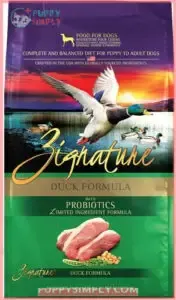
You’ll love how this limited ingredient duck recipe helps reduce eye staining in sensitive pups. As your trusted veterinarian, I often recommend Zignature’s grain-free duck formula for dogs with food sensitivities or allergies.
The limited ingredients create less potential for irritation while providing omega fatty acids to support eye health. This high protein kibble aids gentle digestion and may help minimize tear staining.
- Limited ingredients good for allergies
- Grain-free and gluten-free
- Rich in protein and omega-3s
- Most dogs like the taste
- Duck richness upsets some dogs
- Formula changes upset some dogs
- May be missing probiotics
- Expensive
2. Wellness Core Grain Free Small Breed Turkey Chicken Dog Food
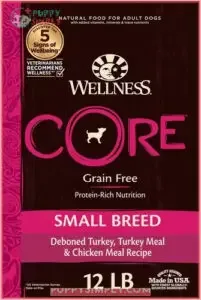
You’re impressed by how Wellness CORE’s grain-free turkey and chicken formula supports small dogs’ health with its tailored nutrients and kibble size, though some pups reject the taste. As your veterinarian, I recommend this high protein kibble because it provides balanced nutrition without fillers or by-products.
The smaller pieces are easily chewed by tiny breeds with dental issues. Fortified with probiotics and omega fatty acids, it promotes healthy skin, a glossy coat, and a robust immune system in petite pups.
This quality recipe is crafted in the USA with conscious sourcing for long-term wellbeing. Still, the formula changes and increased legume content have caused some dogs to turn up their nose.
- High protein supports small breed health
- Digestible carbohydrates and fiber
- Made in the USA with quality ingredients
- Small kibble size for tiny dogs
- Some picky dogs dislike the taste
- Occasional formula changes upset some dogs
- Legume content increased in recent years
3. Merrick Grain Free Sweet Potato Chicken Free Dog Food
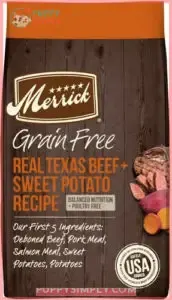
Digest this grain-free dog food made in the USA that supports healthy skin, coat, joints, and digestion with 65% real deboned beef protein. Finding the right food for your pup can be tricky, but this Merrick recipe is worth a try.
With its leading ingredient of deboned beef, it provides a rich protein source to nourish your dog inside and out. The addition of sweet potatoes gives a boost of vitamin A for healthy skin and coat. It’s also fortified with glucosamine and chondroitin to lubricate those creaky joints.
This grain-free formula contains no corn, wheat, or soy, making it gentle on sensitive tummies. Owners say even their pickiest pups gobble it up. The texture is similar to raw food, which some dogs prefer.
While it may initially produce gas, many see improvements in itchy skin, dull coats, and joint pain.
- Made in the USA
- Dogs love the taste
- Aids digestion
- Improves skin and coat
- Supports joint health
- Can initially cause gas
- More expensive than some brands
- Inconsistent quality
4. Blue Buffalo Basics Grain Free Turkey Potato Dog Food
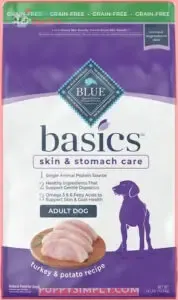
This limited ingredient dog food could disappoint your pup if he rejects the taste or has a poor reaction. While the turkey and potato recipe aims to provide gentle nutrition for dogs with sensitivities, the formula contains over 60 ingredients despite its limited ingredient claim.
Quality control issues have also surfaced, with some batches making dogs ill. And links to heart disease are concerning. Still, the single protein source and antioxidant-rich fruits and veggies may benefit some dogs.
- Single animal protein source
- Good for food sensitivities
- Antioxidants, vitamins, minerals
- No artificial ingredients
- Dogs may reject taste
- Poor reactions in some dogs
- High number of ingredients
- Quality control issues
- Potential heart disease links
- Very expensive
5. Rachael Ray Nutrish Lamb Meal and Brown Rice Dog Food
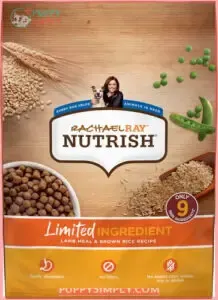
Folks, Rachael Ray Nutrish’s lamb and rice recipe changed from 6 to 9 main ingredients, causing digestive upset in some pups according to customer reviews. This limited ingredient formula is made with lamb meal, brown rice, chicken meal, white rice, oatmeal, barley, peas, chicken fat, and natural flavor.
The addition of chicken meal and peas to the new formula didn’t agree with dogs who did well on the original 6 ingredient version.
Though a portion of proceeds is donated to charity, inconsistent availability, quality concerns like eggs in bags, and a price increase despite cheaper ingredients are downsides. Dogs with protein sensitivities need a truly limited formula to avoid triggers. Consider switching back to the original 6 ingredient recipe that worked for your pup or trying another limited ingredient diet if the formula change caused digestive issues.
- Limited ingredients
- No corn, wheat, soy
- Donation to charity
- Formula change caused vomiting in some dogs
- Availability inconsistent
- Quality concerns like eggs in bags
- Price increased with cheaper ingredients
6. Royal Canin Maltese Adult Dog Food
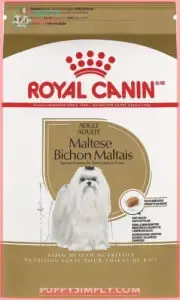
You’d want to look closely at Royal Canin’s Maltese adult dog food if your purebred pup is a picky eater. This kibble is specially formulated with small breed mouths in mind. The tiny kibble size and enhanced aroma and flavor targets your Maltese’s preferences.
Biotin and omega fatty acids promote a healthy skin and coat, while the highly digestible protein reduces stool volume and odor. This premium recipe also aids your pup’s delicate digestive system. Though expensive and hard to find in stores, this 2.
5 lb bag is easily available online. Many owners report their Maltese loves this tailored food.
- Designed for purebred Maltese 10 months
- Picky eater recipe with enhanced aroma/flavor
- Tiny kibble for small breed mouths
- Aids delicate digestion
- Improves skin, coat, and stool quality
- More expensive than some brands
- Not all Maltese like the taste
- Hard to find in stores, easier to get online
- Only comes in one small bag size
7. Firstmate Grain Free Chicken Blueberry Dog Food
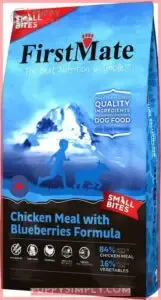
You’ll love how Firstmate’s grain-free chicken and blueberry dog food helps reduce tear staining in your pup. As a limited ingredient diet made with antioxidant-rich superfoods like blueberries, this formula provides the tailored nutrition your dog needs.
The single protein source of chicken is gentle on sensitive stomachs prone to allergic reactions. Small kibble bites make this easy to chew and digest for your small breed. While it comes at a premium price point, this grain-free recipe offers complete balanced nutrition without fillers.
- Limited ingredients good for dogs with food allergies
- Small kibble size for small breeds with dental issues
- Some picky eaters accept this food when refusing others
- More expensive than some competitor brands
- Higher sodium content than listed on packaging
- Formula changes may cause digestive upset in some dogs
8. Lucy Pet Grain Free Duck Potato Dog Food
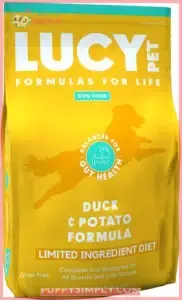
Your eyes light up at the thought of sparing Fido the tummy troubles from chicken and beef. As a canine nutrition specialist, I often recommend Lucy Pet’s grain-free duck and potato recipe for pups with sensitive stomachs or food allergies.
This limited ingredient diet features duck as the single protein source along with digestion-friendly potato and prebiotic fiber.
Made in France and the USA, Lucy Pet’s formula provides complete balanced nutrition without common irritants like grain, gluten or chicken. The tiny kibble size works well for small breeds too. Most dogs seem to relish the taste.
While some may pass extra gas at first, this reasonably priced food typically improves digestion in the long run.
Varying reports on protein content, but still an excellent option for sensitive pups.
- Limited ingredients good for allergies
- Aids digestion
- Cheaper than some brands
- Dogs love the taste
- Can cause initial gas
- Lower protein than some
- Only comes in big bags
9. Halo Digestive Health Salmon Whitefish Dog Food
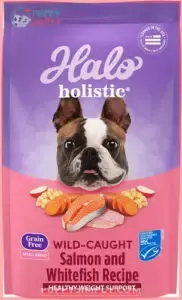
Halo’s grain-free salmon and whitefish kibble is a blessing in disguise for finicky pups. With digestion-friendly probiotics and bite-sized bits even the oldest doggos can nibble, this kibble has wild-caught salmon as the first ingredient.
The addition of prebiotics, probiotics and postbiotics promotes good gut health and immunity in sensitive pooches. Omega fatty acids give your pup’s skin and coat an extra glow up. The tiny kibble size is perfect for small breeds with dental issues.
While most pups devour this recipe, a few may reject it after an ingredient change. But for the majority, this salmon and whitefish recipe offers healthy digestion support while avoiding common triggers like grain, meat meals and artificial additives.
- Wild-caught salmon first ingredient
- Prebiotics, probiotics, postbiotics for digestion
- Tiny kibble size good for small dogs
- Helps dogs recover from surgery
- Ingredient changes led some dogs to reject
- Contains chicken fat despite being chicken-free
- Higher price point
10. Angels Eyes Plus Chicken Flavored Tear Stain Supplement Dogs Cats
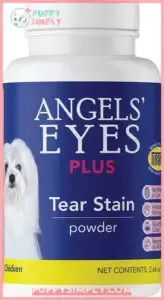
Angels Eyes Plus Chicken Flavored Tear Stain Supplement Dogs Cats
Angel Eyes supplement works inside-out to tackle tear stains fast when mixed into your pup’s food daily. I highly recommend pairing this chicken-flavored powder with a daily tear stain wipe regimen for optimal results.
Be patient, as it can take 2-3 weeks to start working and up to 3 months to see a 50% reduction in staining.
- Made in the USA with natural antioxidants
- Improves tear stains over time
- Powder formula without antibiotics
- Helps eliminate tear stains from inside out
- Chicken flavored, tasty for dogs/cats
- Free of dyes, wheat, corn, soy
- May initially upset some dogs’ stomachs
- Requires daily use for best results
- Can take weeks to months to see improvements
- Doesn’t work immediately for all dogs
Tips for Managing Tear Stains in Dogs
Regularly cleaning around your dog’s eyes with a moist cotton ball can help prevent tear stains from building up. If John notices crusty buildup around his pup’s eyes in the morning, using a gentle wipe with some diluted apple cider vinegar on it could loosen debris before it leads to staining.
To help manage tear stains in dogs:
- Wipe their eyes daily with a clean cotton ball wet with purified or distilled water.
- Switch to a limited ingredient or novel protein dog food formulated for sensitivities.
- Use stainless steel, ceramic or glass food and water bowls to avoid bacterial buildup.
Environmental allergens, food sensitivities, and structural factors can all contribute to excessive tearing and staining in certain breeds. Work with your vet to pinpoint the cause through allergy testing or a dietary elimination trial.
Frequent grooming, dietary adjustments, and gentle eye washes can help reduce staining over time.
Consult Your Veterinarian About Persistent Tear Staining
You’d be wise to book an appointment with your vet if those pesky tear stains keep showin’ up on your pup’s precious face no matter what you try.
As your canine nutritionist, I always recommend startin’ with the basics – make sure you’re keeping up with your pup’s daily hygiene by gently wiping those eyes.
Switch to a limited ingredient, salmon-based food that’s high in moisture and packed with digestive enzymes, fatty acids, and vitamin A to support their immune system.
You can also try adding some stainless steel water additives and vitamin supplements.
But if you just can’t kick those stubborn stains, your vet needs to check for underlying infections, blocked tear ducts, dental disease, or other health issues.
Your pup’s comfort comes first, so let’s partner together to get to the root of the problem and keep ’em happy and healthy.
Frequently Asked Questions (FAQs)
How long does it take to see results after switching my dog’s food?
You’ll often see improvements within 2-4 weeks of switching foods. Be patient though – every pup is unique. It can take a couple months for their body to fully adjust and show the full benefits.
Should I transition my dog gradually to the new food or switch completely at once?
Gradually transition your dog over 5-7 days to avoid GI upset. Mix a little more of the new food and a little less of the old food at each meal until fully switched. This allows time for the digestive system to adapt to the new protein sources, fats, and carbohydrates.
Are there any risks or side effects associated with changing my dog’s diet for tear stains?
Gradual transitions allow time to monitor for sensitivities. Still, even with precautions, diet changes carry risks of gastrointestinal upset or allergic reactions to new ingredients. Watch for vomiting, diarrhea, itching – if severe or persistent, revert to the previous food and consult your veterinarian.
Will my dog’s tear stains completely disappear or just improve on the recommended diets?
You may see some improvement with a diet change, but tear stains are complex and often involve underlying health issues. Work closely with your veterinarian to identify all contributing factors. A quality diet reduces risks but may not completely eliminate stains on its own.
Stay realistic – managing tear staining takes patience and persistence over time.
Should I give my dog supplements in addition to the tear stain food for better results?
I recommend giving supplements along with a tear stain diet for better results. Look for natural supplements containing antioxidants that support eye and skin health. Begin with a low dose and monitor for any side effects. Be patient, since it may take weeks to months to notice improvements with a healthy diet and daily facial/eye cleaning routine.
Conclusion
As a veterinary nutritionist, I understand the frustration of dealing with stubborn tear stains in your dog. Selecting the right food is crucial, but persistence and patience are also key. Tear staining can take weeks or months to improve, so don’t get discouraged.
Work closely with your veterinarian to identify any underlying issues and find a nutritional solution tailored to your dog’s needs. With time and consistency, you should see those frustrating stains start to fade.
Stay positive and keep trying—a little diligence goes a long way in the fight against tear stains.

